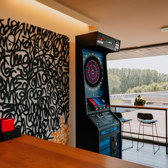Model-Driven Apps with Microsoft Dataverse in Power Apps
UCDS
5 days
Interested in a private company training? Request it here.
Not ready to book yet? Request an offer here.
Introduction to the Microsoft Power Platform
The Power Platform is a powerful combination of tools that allow you to build business applications to store, process and share your data. This chapter will show you how the Power Platform is built and gives you an overview of what is possible.
- Overview of the Microsoft Power Platform
- Overview of Power Apps
- Introduction to Microsoft Dataverse
- The Common Data Model
- Dynamics 365 Sales, Customer Services, ... as Model-Driven Apps on Microsoft Dataverse
Overview of Model-Driven Apps and Dynamics 365
Before Model-Driven Apps can be created, an environment with a Microsoft Dataverse database must be provisioned. This chapter introduces the concept of an environment and what role it plays in creating, managing and deploying Model-Driven Apps. Students are also provided with a quick overview of the look and feel that every Model-Driven App has and the common functionality of Model-Driven Apps.
- Creating and Working with Environments
- Navigating and Using a Model-Driven App
Working with Solutions
Solutions are used by developers to package related customizations together so that they can be managed and deployed as a single unit. We will see what components can be added to a solution and how they are the essential building blocks of your environment.
- Working with Solutions in Environments
- Default Solutions in an Environment
- Adding Components to your Solutions
- Creating Solutions and Solution Publishers
- Importing and Exporting Solutions
- Managed versus Unmanaged Solutions
- Solutions and Managed Properties
- Versioning Solutions
- LAB: Working with Solutions
Creating Model-Driven Apps
Model-Driven Apps are the building blocks of any business solution. For instance, we could create our own "event management" app. The app will group together everything our user needs from Microsoft Dataverse and the components we have built.
- Concepts of a Model-Driven App
- Creating Model-Driven Apps
- Adding Pages to Model-Driven Apps
- Defining the Model-Driven App Navigation
- Configuring the Model-Driven App Settings
- Managing Apps in Solutions
- LAB: Create a Course Management App
Creating and Customizing Tables
Tables are used to model and store business data in Model-Driven Apps. Conceptually, they are similar to tables in a relational database. Microsoft Dataverse provides several built-in tables, such as Contact and Account, but customizers will almost always need to create new tables. In this chapter, you will learn all aspects of creating new tables.
- Creating and Configuring Tables in Microsoft Dataverse
- Diving into the Table Settings
- Standard, Activity, Virtual and Elastic Tables
- The Default Table Columns, Forms and Views
- Creating Custom Activity Tables
- LAB: Creating and Configuring a Course Data Model
Managing Relationships
Just like accounts and contacts have relationships in Microsoft Dataverse, we can provide relationships for our own tables. You will learn what types of relationships are possible and how to configure them.
- Creating and Using Relationships - 1:N, N:N
- Defining Self-Referential Relationships
- Working with Column Mappings to facilitate data entry
- Connections and Connection Roles
- LAB: Managing Relationships between the Course Management Tables
Creating and Customizing Columns
Columns define the individual data items that can be used to store data in a table. You will learn everything about data types, formats, column properties and more.
- Adding Custom Columns to Tables
- Supported Column Data Types
- Working with File and Image Data Types
- Working with Lookups
- Creating Multi-Table or Polymorphic Lookups
- The Choice and Choices Data Types
- Using the Status and Status Reason Columns
- Defining Alternate Keys for a Table
- Aggregating Data with Rollup Columns
- Calculating data based on other columns with Calculated Columns
- Creating Formula Columns using Power FX
- LAB: Creating Columns to store Course Data
Customizing Forms
Forms are used to create, read and update individual table rows. In this module you will learn about the different Form Types and how to create or customize forms using the Form Designer.
- Main Form, Quick View Form, Quick Create Form and the Card Form
- Create and Configure Forms
- Defining the Structure of Forms
- Configure and Use Quick Create, Quick View and Card Forms
- Working with Custom Components
- Embedding Canvas Apps in a Form
- LAB: Creating and Configuring Forms for the Course App
Business Rules
Business rules essentially automate control logic on tables, without the need for development. Think of making columns required depending on the value of another column for instance.
- Create and Apply Business Rules
- Defining the Scope of Business Rules
- Business Rules Limitations
- LAB: Hide Values Dynamically via Business Rules
Creating and Using Views
Offer the data needed for different scenarios with views. With a view, we can either look at all table rows, or we could apply some filtering, sorting, etc.
- Examine the Different Types of System, Public and Personal Views
- Create New Public Views and Modify Existing Views
- Configure Quick Find, Advanced Find, Associated and Lookup Views
- Configure Views with Custom Controls like the Editable Grid, Calendar Control,...
- LAB: Creating Views and Configuring a Calendar View
Reporting in Model-Driven Apps
Reporting is essential when working with data. In this module, you will learn how to create charts and dashboards that turn raw data into clear and engaging visualizations, such as bar and column charts.
- Build Interactive Charts to show in Views or on Dashboards
- Classic Dashboards showing Charts, Data or Web Pages
- Interactive Dashboards with dynamic sorting and filtering
- Working with the Tabular Data Stream (TDS) endpoint
- LAB: Create Charts and Dashboards in the Course Management App
Creating Business Process Flows
Business process flows in Dataverse are guided workflows that streamline and standardize processes within an organization by providing a visual representation of the steps needed to complete a task. They ensure consistency and compliance by guiding users through predefined stages and actions.
- Creating a Business Process Flow
- Defining Stages
- Linking Multiple Tables in a Business Process Flow
- Using a Business Process Flow
- LAB: Creating and Using a Business Process Flow
Securing Model-Driven Apps
This module teaches how you can implement a robust security model in Model-Driven Apps using Business Units, Security Roles, Users and Teams.
- Building a Security Model
- Business Units and their Role in Security Modeling
- Define Privileges and Access Levels in Security Roles
- Creating and Maintaining Users
- Team Management
- Securing Apps, Data, Forms, Views, Dashboards and Business Process Flows
- LAB: Implementing Security for the Course App and Data
Power Platform Automation
Power Automate gives you the ability to automate organizational processes. As a part of the Microsoft Power Platform, it integrates seamlessly with Model-Driven Apps and Microsoft Dataverse.
- Power Automate Overview
- Trigger a Flow Based on Create, Update or Delete operations
- Consuming Microsoft Dataverse Data in a Power Automate Flow
- Available Actions with the Microsoft Dataverse Connector
- LAB: Automate Sending a Confirmation Mail in the Course Management App
Built on the fundamentals of Dynamics 365, Model-Driven Apps allow you to build complex and sophisticated business apps without writing code. Model-Driven Apps follow a data-first approach. You first design the data model of your Model-Driven app using Microsoft Dataverse and then you compose the UI of the Model-Driven App. Unlike Canvas App development where the designer has complete control over app layout, with Model-Driven Apps much of the layout is determined for you and largely designated by the components you add to the app. Follow this 5-day course and become an expert in Model-Driven App design, Microsoft Dataverse and the integration with other components of the Power Platform like Power BI, Canvas Apps and Power Automate.
This 5-day course is intended for power users, consultants and key business users that want to work with and customize the out-of-the-box functionality of the Power Platform.











